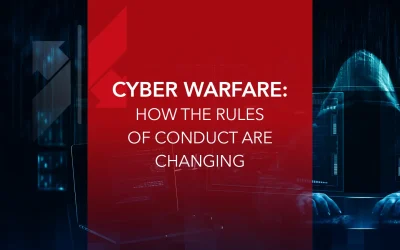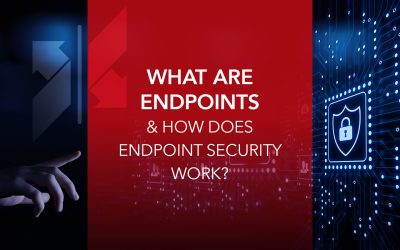Summary of Key Points
- XDR empowers organizations with holistic security while reducing administration and management
- XDR reduces reliance on human resources, using AI to “screen” false alerts and alert the cybersecurity team when appropriate
- XDR monitors your entire network as opposed to singular channels or devices
- XDR is ideal for organizations that process sensitive information (payment data, customer information, etc.) or organizations in regulated industries
- XDR acts as a strong second and third level of defense

An Introduction to Extended Detection & Response (XDR)
Modern digital security requires a more complex approach than simply installing antivirus software and setting up a firewall. While those activities are certainly important, hackers today are far more sophisticated, and you need to have additional layers of protection in place to keep your IT environment protected.
For many organizations, Extended Detection and Response (XDR) solutions are the ideal way to get the holistic security that they need while still allowing for simple administration and management. Read on to learn more about what XDR is and how it may benefit your organization.
See also:
- Our managed open XDR services
- Our managed firewall services
- Our managed endpoint detection and response services
What Exactly Is XDR?
XDR is a relatively new idea to the concept of threat detection and response. The term itself was only coined in 2018. While there are varying definitions, ultimately, XDR unifies disjointed and fragmented security solutions and data sources to provide organizations a single pane of glass for threat detection, investigation, and response.
Once implemented, XDR delivers a more unified and holistic approach to defend against all types of attacks, including standard cyberattacks, misuse of networks, unauthorized access, etc.
XDR is designed to actively learn about evolving threats through artificial intelligence and machine learning technologies. In many ways, XDR is the next major step forward for both endpoint detection and response (EDR) and managed detection and response (MDR), both of which have been long-standing key security components for organizations that need to keep their networks safe.

How Does XDR Work?
XDR takes a more proactive approach to threat detection and response than a standalone EDR or SIEM solution. An effective XDR solution automatically correlates all telemetry to drive detection, as opposed to narrowly focusing on endpoints. This telemetry focus helps to not only provide greater visibility into threats in your environment, but also allows for easier administration and management of your security efforts.
Some of the most significant ways that security engineers can benefit from XDR include:
- Detecting Sophisticated Threats – Modern cyberattacks do not require infected files to be successful. Instead, these cyber attacks are done through attacks on your website, DNS attacks, SQL injections, URL interpretation, and more. XDR actively monitors all traffic to detect anomalies to determine what is legitimate and what is a threat so that it can be blocked.
- Tracking Threats Across Devices and Sources – XDR offers a holistic approach to cybersecurity. It does not simply monitor one threat location such as endpoints or user activity. Instead, it monitors traffic throughout your network so that potential threats can be spotted no matter where they occur.
- Collecting and Analyzing Data from Multiple Sources – In addition to simply monitoring the traffic, files, and other data points throughout your network, XDR collects data trends so that automatic correlation can determine abnormal activity within your network. Each day your security environment becomes more secure by XDR’s automatic correlation and AI.
- Quicker and Custom Alerting to Unknown Threats – While XDR automatically reacts to varying threats, you can customize what you and your team needs to know when a particular event arises.
To put it simply, XDR goes well beyond just watching your network for known threats and responding to them. XDR delivers a solution that centralizes all of your organization’s telemetry (across numerous tools and sources), correlates your telemetry, and equips you to detect and respond to more threats than ever.
Who Needs XDR?
Properly speaking, any company that wants to make sure that their environment is as safe as possible would at least want to consider adding XDR to their cybersecurity strategy. This would include companies that collect and store private customer data, companies that have any type of proprietary data on their systems, and companies that operate within regulated industries.
The reality is, however, that XDR may be ‘overkill’ for some organizations. Many small businesses that use their computer systems for little more than communication and inventory tracking, for example, may not need to invest in an advanced security suite given their risk profile.
When a company falls victim to a cyberattack that results in customer data being compromised, they are often unable to recover from the financial losses or the loss of reputation. Depending on your company’s risk profile, investing in a more comprehensive security solution like XDR makes sense.

What are the Benefits of XDR?
XDR offers many different benefits to your company that go well beyond a simple improvement in the level of security that is in place. Every organization faces unique challenges related to security and will experience benefits specific to their circumstances.
The following are some advantages that virtually every company will appreciate once they have XDR in place:
- Immediate Protection Against Known and Unknown Attacks – As soon as you implement XDR into your system you will begin benefiting from its advanced monitoring and detection. Out of the box, it is able to block all known types of threats and also watch for new and unknown threats.
- Reduced Alert Fatigue for Your Security Team – XDR is able to detect and react to threats without the need of human intervention in the vast majority of situations. This means there are far fewer alerts that need to be presented to your cybersecurity or network operations teams in real time. This can help to reduce alert fatigue so that your teams are able to be more effective in their roles.
- Optimizing Technical Resources – While XDR and other software systems are extremely good at many things, there are some activities that are done best by real people. Allowing XDR to provide advanced threat detection and response, your technical teams will be freed up to work on additional projects where they will be more valuable.
- Continuous Improvement Over Time – Since XDR has AI technologies built right in, it is able to continuously learn and improve over time. This means that the protection your systems have will naturally evolve and improve to ensure they remain effective against whatever threats the future may hold.
- Rapid Restoration of Functionality After Compromise – In the event that one of your systems is compromised, XDR is able to quickly isolate it and help to clear off any problems. This helps to minimize downtime as well as reduces the risk of a compromised system from infecting other areas of your environment.
- Effective Security for Local and Cloud Environments – Most companies today utilize both local and cloud based environments. XDR is able to actively monitor and protect all types of environments to ensure your entire system is safe.
- See also: Cloud Isn’t the Future, It’s the Now
Where Should XDR Fit in Your Security Posture?
When developing your digital security strategy, you will need to make sure that your environment is protected at every level.
In general, the first line of defense is going to be the common practices such as a good username and password policy, proper access control strategies including authentication, and other solutions that are built right into the environment.
XDR strengthens your security posture both as a second and third level of defense. In the past, network monitoring tools and concepts such as endpoint detection and response (EDR) would be used to monitor systems and report up to the third level (humans) in order to mitigate the threat. Since XDR offers advanced monitoring as well as threat mitigation systems, XDR can be used to reduce the number of alerts requiring human review.
How to Find A Strong XDR Partner
If you want to implement XDR into your environment, you will want to work with an experienced managed security services provider. When determining which MSSP to work with, you want to make sure that you choose one that is able to handle every aspect of your XDR implementation and management. This means working with a team that has worked extensively with leading XDR technology partners. Virtual Armour has worked with businesses of all sizes in multiple industries including energy, finance, healthcare, retail, and more. We are focused on providing industry leading cybersecurity solutions to all of our clients, and we are ready to help you today. Whether you are looking specifically for an XDR partner, or you want full security consulting, we are here for you. Contact us to speak with an expert and learn how we can help protect your systems from the ground up.







